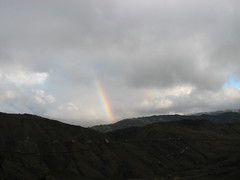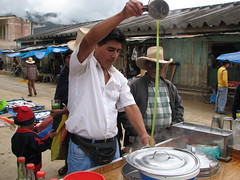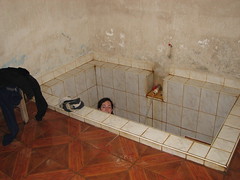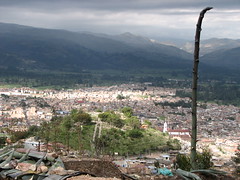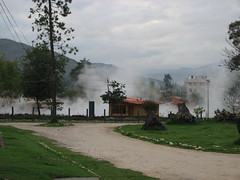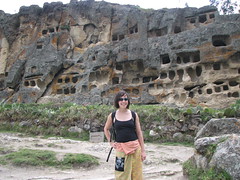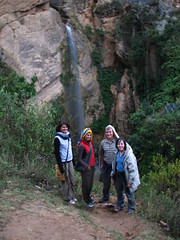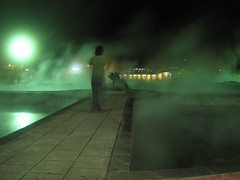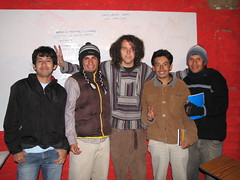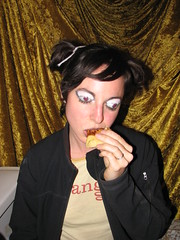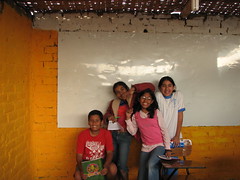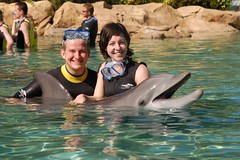Kim and I just got back to civilization after being on a farm in Ecuador near Vilcabamba without any form of communication for the past week. Just wanted to let everyone know I’m still alive and will be posting more details on what I’ve been up to later. For now, I’m just enjoying electricity, soft beds and toilets with water again. The last few weeks have been kinda hectic as the plans changed and we spent a bit of time on the road to adjust. It’s relaxing time. I’m going to get a $15, 90 minute massage this evening. Then… pizza. I’ve missed civilization.
Back From the Farm
Leymebamba and the Journey to Ecuador
The journey can really be half the adventure here.
From Celendin we took a beautiful, bumpy, steep, long, fascinating journey to Leymebama. Getting to Leymebamba the man who was going to setup stuff for us to do hadn’t arrived yet, so we spoke to the Belgian volunteers who are currently there. In the end we decided it would be too big a hassle to try to force a project for a month and then leave with possibly no replacements for what we’ve done. So we decided to go to Ecuador until December.
Day 1
Getting to Ecuador was two full days of travel that was exhausting, but interesting. We began the journey from Leymebamba at 5AM on a crowded combi (shared minivan) to Chachapoyas, the nearest “city”. I can tell I’m getting used to combis because I was actually able to sleep a little bit despite my head bobbing in every direction.
Chachapoyas kinda sucks. And we were stuck there allllllll day because the road from Chachapoyas back to the next main highway is being widened and paved to a two lane road, and so is closed from 6AM until 6PM. We played in on the really slow Internet and sat around in the city until we could escape. Our route out of Chachpoyas to Ecuador we kinda had to figure out as we went since there’s no direct buses to almost anywhere we want to go.
From Chachapoyas we took a bus to Baguas, from Baguas we hurriedly caught another bus to Jaen and then we spent the night in the nearest cheap hostal we could find. Phew.
Day 2
From Jaen you’re pretty close to the Ecuador border – distancewise. However the roads are bad so timewise it’s another full day. From Jaen it’s another combi to San Ignacio. From there it’s a shared taxi to the border, and by shared I mean a standard hatchback car, but with 3 people in the front and 4 people in the back seat. Nobody talked, but man were we all close – for a long time over a very bad road. This gets us to the border in the middle of nowhere though.
We had heard that this border crossing was out there, but we didn’t expect that there would be no guards, and the people who do paperwork take 3 hour lunch breaks, and then once you’re on the Ecuador side there’s no transportation until a farmer comes at 5:30PM to haul you to Ecuador in a truck. We just hung out in the river and went for a swim while we waited about 4 hours for everything to get ready.
The farmer truck was a fun form of transportation with little wooden benches – until it got dark, crowded and started pouring and blowing rain. After enduring that we arrived in Zumba and promptly bought a bus ticket outta there. We heard there weren’t any ATM’s in Vilcabamba (turns out there is one now), so we went straight to Loja for the night. Phew. Those were two long days of traveling. As my father commented, traveling here can be hard on your butt, in more than one way.
Now we’re in Vilcabamba, where people supposedly live forever and there’s a ton of foreigners. It’s quite a bit more expensive than Peru, but I attribute that to all the foreigners. It seems like all the really interesting businesses here are started by foreigners. There’s a vegetarian restaurant run by a French women, the coolest hostals are run by Canadians, and Europeans, the farm we’re going to volunteer on is owned by an American woman, and the most recommended local guide is from New Zealand. It’s kind of a shame that as a generalization in many South American countries the locals don’t get more creative than to open the same exact businesses that everyone else opens.
Anyway, we’re off to a farm a little ways out of Vilcambamba that Kim found online. I haven’t read as much about it as she has, but hopefully it’ll be cool. There won’t be internet or any other form of communication there, so it may be a while before I post anything again.
CelendÃn
We’ve really left the gringo trail now. From Cajamarca we took a 10 sole ($3.33) 6 hour bus ride toward Chachapoyas to Celendin on unpaved roads. Even though the roads were unpaved, the trip was quite a bit more comfortable than the one from Trujillo to Cajamarca. They’re also widening the roads all the way to Celendin and I believe they’re going to pave them too. Celendin was much more modern than I expected after going so long without seeing any major civilization. It’s actually a fairly pretty little town that I’m sure will start attracting more tourists with the completion of the highway.
We checked into a hostal and got a small dinner. A rather common occurence at restaurants is to pick something off the menu and then be told they don’t have it. I think we tried to choose 2 or 3 different things from the menu at Hostal Celendin that weren’t available. In general the service is terrible too. After the food comes you have to hunt your waiter or waitress down to get anything additional including the check. I guess that’s why there’s no tipping in Peru.
6AM was wakeup time to get to Llanguat and some hotsprings. We considered walking the 21km to get there, but decided against it as it began to rain. Instead as far as the guide book indicates there’s only a 7AM combi to Llanguat. Little did we know combi meant people and livestock carrier. We shared a 2 hours trip down an insane number of switchbacks with a loaded combi full of people, sheep and chickens. Kim had to keep pushing a lamb back to keep him from stepping on the other animals.
We passed through Llanguat, which looks like about 15 houses and a church, and the combi dropped us off at the hotsprings. Unfortunately we couldn’t try the mud baths since the river was too high and uncrossable. We went in the pool, which could easily be mistaken for the mudbaths. After an unsuccessful attempt to find a river crossing, we relaxed for a bit in the inside hot pools like there were in Cajamarca, only the water wasn’t as hot. The owner of the place was very friendly and was very interested in learning how to better develop a tourist industry. It sounds like more than a few people in the Celendin area feel this way.
Getting back proved to be a bit of an ordeal. We walked in the rain for close to 2 hours back up the switchback road before a combi finally came by. We hopped on and got 2 of the most umcomfortable seats. My butt still hurts. I don’t know if the 2 hours of hiking uphill in the rain or the remaining hour in the combi made me more tired, but once we got back to Celendin we ate dinner and went to bed, which means that we didn’t have time to visit the local village of Jose Galvez where the women are supposedly the most beautiful in Peru.
Cajamarca
Kim and I left Huanchaco with some French volunteers named Priscille and Maelys and her fiance Atoine. All the comfortable buses were sold out, so we went with a company named Horna to go to Cajamarca on the 10:45pm bus. The ride was rather painful. It wouldn’t have been all that bad if Kim hadn’t been sick with stomach trouble on a bus with no bathroom. The first part of the ride they put on terrible action movies, ala Jean Claude Van Damme. With three TV screens on the bus only one worked, and nobody seemed to be watching that screen, and yet the volume must have been most of the way up. I swear Peruvians are immune to loud noise. I’m not however. Thank goodness for earplugs. I can handle background noise no problem, but the sounds here go well beyond that, sometimes even with earplugs. Fortunately for Kim they were willing to stop the bus to let her outside when she needed to go.
We arrived in Cajamarca around 5:30AM and got overcharged on a taxi ride to get Kim as quickly as possible to the Banos del Inca, a local hotsprings, where we had a hostal for the night.
The French contingent miraculously slept well on the bumpy noisy ride, so they went to the banos straight away while Kim and I passed out in the hostal for a few hours. We finally woke up a few hours later and went to banos public pool which we weren’t too impressed with. The water was only luke warm and it was crowded with people who swim like they’re drowning and so splash like crazy.
After the banos we went into the centro of Cajamarca to meet up with Priscille, Maelys and Atoine. We did the whirlwind tour of all the major historical sites in the city, sneaking in to listen to other groups’ tour guides when they were available. The sites included a church the Spanish built out of stone they got from tearing down the Inca’s buildings, a museum about tradicional life in the area, and the chamber where the Spanish held the Incan king for ransom for the price of a room filled with gold and two rooms of silver. Pisarro, the Spanish conquistador, it turns out, was quite the asshole. He killed the king anyway after the ransom was paid.
We went to the evening mass at the Catholic Cathedral. I was exhausted by this point and almost fell asleep. If it wasn’t for all the standing up, sitting down and kneeling I would have passed out. I’m really not much for church services, but everyone else seems to have had some Catholic upbringing.
After scouring the market for the last remaining open vendor to buy dinner, we went back to the hostal to prepare little sandwiches with various vegetables and some cheese. Cajamarca is supposed to be famous in Peru for their cheese, and so far I will say it’s much better than the selection we had in Huanchaco or Trujillo. However it’s still not that impressive from what we’re used to at home. In the hostal that evening they were celebrating a barmitsfah by drinking and blasting really loud salsa, cumbia and merengue. And shouting/singing along with music. And sometimes slamming objects down on the table so that it sounded like gunshots. In spite of this I fell right to sleep… for a little while. The gunshot type sounds woke me up, but thank goodness for earplugs.
The next morning Kim and I got one of the private rooms in the banos, which turned out to be really nice. For 5 soles a person we get our own tub where we can fill with super hot hot spring water. The facilities that are private are cleaned between every use, so it’s much nicer than the public pool, even if it’s not outside. Most importantly the water is hotter – much hotter. You really could cook yourself if you’re not careful. You get to control the temperature by mixing in cold.
From the hotsprings we walked a few kilometers along the river to the Ventanillas de Otuzco. These are ancient tombs where they used to stuff the dead into little holes carved into the cliffside. They haven’t been used in long time and are interesting, but not super impressive. The walk there was probably the most interesting part, going through the green pasturelands and seeing the local houses outside of the city. Also interesting was trying Chicha de Jora for the first time. This is a corn beverage that is fermented with saliva. Sounds gross, but it tastes pretty sweet. A liter cup of it was only 1 sole, which is cheaper than water.
To end the day we caught a hard to find combi to Llacanora, a little pueblo about 45 minutes away on a bumpy road. The combi was so filled with people that they actually didn’t stop to pick up some people, which I’ve never seen before. I think there were 25 people in a 4 row van. I wish I could have taken a picture, because words don’t do justice to how full public transportation can get. In the pueblo, we hiked a little ways in the rain to see some waterfalls as the light was fading. Nice and pretty.
Back in Cajamarca we had dinner before Priscille, Maelys and Atoine caught their bus back to Trujillo and Huanchaco, since they still have some time volunteering there. It was really fun to have some other people to hang out with, and they were all amazingly nice, easygoing and well travelled. I hope we run into them again someday.
Today was a little hectic in the morning because the hostal in the city center we were staying in, which we had moved to the night before, didn’t have any rooms because they had all been reserved. We thought that was odd for a Monday night, and all the other cheap hostals were full too. Turns out this is something like spring vacation for all the local school children, so the Peruvians are all vacationing right now. We finally found a place which was 38 soles. The funny part of this place was that they didn’t even have change for a 50 sole bill. Nobody ever has change in Peru. Even major businesses like farmacies with cash registers often will tell you that they are unable to change your large bills. Unfortunately the ATM machines here love to give out 50′s and 100′s when you take money out.
Once we got our hostal and bus ticket bought for tomorrow’s trip to Celedin, we went up to the city lookout, the Cerro Santa Apalonia. There’s a little chapel on top and some very pretty views of the city. We spent a few hours walking around the hilltop and some of the local neighborhoods behind the hill. After a lot of walking the last few days, my legs are beat. For dinner we splurged and got pizza and a place that claimed to be New York style. It was delicious. I’m sure it doesn’t compare to real New York pizza, but after a bit of time here I was very happy for that comfort food.
We went to the Banos again and spent a little longer in the hot water. That’s really a great way to end the day. Tomorrow we may go back again, and if we do I might see about getting a massage, which is only 20 soles. At 1PM we’re leaving for Celedin. The route is supposed to be gorgeous, but the road is mostly unpaved and very bumpy. We’ll see how that goes. At least we’ll be going by day.
One Month In Huanchaco
I can’t believe it’s already been a month in Huanchaco. In some ways I guess I can because it’s starting to feel very familiar. It seems to me that it must be hard as a local making friends with volunteers just to have them leave. When we walk down the main street in town it takes a long time to get to the other end because we’re always running into people we know and then we have to stop and chat. We know all the local bars and restaurants pretty well. We’re even getting better at surfing. However, it’s time for a change. We may come back later, but by that time hopefully the weather will be sunny and warm. I still don’t understand how a desert town, near the ocean and so close to the equator can be as cold and cloudy as this town is. Anyway…
We’re pretty sure we’ve got another volunteer opportunity lined up in a very small town called Leymebamba. There was some miscommunication with the Otra Cosa volunteer coordinators. They thought there was something for us to do in Leymebama when it turns out there’s already volunteers there for the next month. Fortunately the guy who actually organizes the volunteers in Leymebama was in Huanchaco to meet with us. He’s going to find something for us to do, so we could end up teaching English or we might work on developing a recycling project for the community. We’ll find out when we arrive around November 8th. Until then we’re going to go to Cajamarca and some of the surrounding areas to see some touristic stuff.
As far as the last week goes it’s been busy and fun. Otra Cosa had a Halloween party. There was a fun mix of international volunteers and Peruvians. We decorated, danced, drank, talked and had a great time. We went to a local brew pub called Hops that actually had a dark beer, a dunkel. Pretty much all Peruvian beer is Budweiserish – light in color and taste. It’s not bad, but it’s not what I’ve gotten used to living in Seattle. After the beer we went out dancing until 5 in the morning at La Barra. There’s been a few small going away parties for other volunteers too. Overall, a lot of excuses for partying.
I’ve gotten some work done too. I taught my last class today. I took my three students to lunch to have them practice ordering food in English. They all ordered fried chicken, I think because they thought it was easier to just say what the first person said. I’ve done a bit more work on the espaanglisch page, although I may want to change some more things about the look when I have time. David should now be responsible for updating all the content on his own. I even got a little work done for my former U.S. employeer over the internet. Hopefully the start of my career where I can work from anywhere.
After our next volunteer project we’re considering taking December to go to Iquitos in the jungle. From there we’ll head down the Amazon river to border of Brazil, Peru and Columbia. Turns out we need visas to enter Brazil and they’re $100 each, so we’re going to try to catch a flight to Bogota, Columbia, from there. Then we’ll explore Columia a bit and work our way back down through Ecuador, finally returning to Peru and probably making a stop in Huanchaco to see how people are doing. Of course, this is a tentative plan and anything could change.
Week 3+ in Huanchaco
It’s been a good week since moving. I didn’t surf as much as I wanted to because I wanted to let an injury to my toe heal, but as it was close to being better I slipped and stubbed my injured toe. Ouch. Oh well. I got Kim to start going out with me and she’s rocking the surf scene. We’ve been taking a few lessons from Juan Carlos from Un Lugar Surf School. Kim got hit in the nose with her board the other day. Overall though we’re having tons of fun even if it’s a little cold. There’s been more sunny days lately.
I’ve had ups and downs teaching. Some days I really enjoy it. Those are the days when I feel like my small class of three students listens and learns. It’s rewarding to see students “getting it”. There’s some days though where I feel like I’m in front of a pack of crazy brats. I know an hour and a half is a long time to sit and learn stuff, so I try to make it as active and entertaining as possible. I’ve found with such a small class doing a question and answer format seems to work best for me. I ask them questions about the material until they start to seem comfortable, then I have them ask each other questions. Sometimes we do a jeopardy style game, sometimes spelling bees, sometimes bingo, and other games too.
I’ve got the page up for Espaanglisch, the school I’m working for, even if it needs some polishing. David Mercedes is the head of the organization and the best Peruvian friend I’ve made here. He’s passionate about languages and cultures, and I hope the organization can make good use of the new web presence.
We haven’t gone too far out of the city since we’ve been here, which has been really quite nice. We keep meaning to take a weekend trip to Chiclayo or someplace a few hours away, but the chill atmosphere keeps us nearby. We visited some more ruins called the Huacas del Sol y Luna. I think they were cooler than Chan Chan since they were better preserved. They’re temples that are pretty big since every hundred years they’d fill up the temple with bricks and build a new level on top of the old.
I’ve got some interesting observations about culture and people here:
- Wall clocks never work. They either don’t have a battery or have the wrong time
- People here have a higher tolerance for noise. Honking horns, blaring stereos, skipping movies, constant contruction, and barking dogs don’t seem to phase the locals
- There’s no such thing as too full when it comes to local transportation. Even if the aisles are stuffed, people are sitting in each others laps, and the ticket man is hanging out the door the combis will stop for more people.
- Business hours are flexible. Even more so than Spain where the siesta was at a consistent time. There’s one restaurant that was open only a couple times in our first two weeks. Now it’s open all the time. Sometimes the restaurant will appear open when there’s nobody there to actually cook. Sometimes the wait staff will tell you this, sometimes they won’t…
The end of the month is approaching quickly, and we’re not sure exactly what we’ll be doing. We’ve had trouble getting the Otra Cosa volunteer coordinators to nail down our next volunteer project, so we may just head north to Ecuador for a little while before we figure out what we’re doing next. We might end up doing a project near Iquitos, in the jungle, but it’s all up in the air right now. Whatever happens, I’m sure it will be fun and interesting.
Week 2 In Huanchaco
The biggest change this week has been that we moved out of our first living place with Wilma and into a room across town that’s a lot nicer. It actually feels like we’re living indoors now, which makes it feel a lot warmer. The best part is how quiet it is. We were able to sleep in until 9 today without any problem. Normally I’ve been lucky to get any sleep after 7AM. The room is carpeted too which I really find nice. I can stretch on the floor and not be absolutely freezing because of cold tile. We’ve got a rooftop view and a really nice attached, private bathroom too. And someone has a wireless connection open!!!!!! I can connect to the Internet from my room again. We’ve only been here two days in the new place, but we’re already happier. Oh, and the price is the same. Go figure.
I’ve been surfing almost everyday. I took a day off because I hurt my toe playing soccer, but I’m getting to the point where I can catch most decent sized waves. Yesterday my main problem was that there weren’t enough decent sized waves. It’s a lot of fun, although I do wish the sun was out so that it was warmer. It’s amazing it’s been so cold considering we’re only 8 degrees from the equator.
My small rant for the week is that there’s no toilet paper in any public bathrooms. You really have to carry some with you at all times. We went to a jazz concert a few days ago and the bathrooms at the theater had no toilet paper, no hot running water, no soap, and nothing to dry your hands. I’m amazed by the lack of such simple sanitary things. Kim and I have each had boughts of stomach problems. I think we’re becoming immune to some stuff here. The locals don’t get sick too often, which could still mean up to once a month. That’s still an awful lot of sick time due to bad sanitation and hygiene. And one local tells us that if he travels to some other city in Peru he’ll probably get sick there because he’s not immune. Hopefully there’s some sort of educational campaign at some point.
Yesterday Kim and I went with some other volunteers to the ruins of Chan Chan. It was a huge adobe city hundreds of years ago, and I didn’t even realize it, but the highway that I’ve been taking back and forth from Trujillo to Huanchaco passes right through the ancient city. Only a small part of the city has been excavated and restored. It’s mostly brown and dry, but there’s one room that you walk in and it’s full of water, plants and birds.
After visiting the ruins we went to David’s, the guy who’s running the Espaanglisch program I’ve been working for, and he cooked dinner for my birthday. A bunch of the other volunteers showed up and we ate, drank and talked for a while. It’s really fun to hang out in multicultural groups. Fortunately for Kim and me English is the common languange, so even with Peruvian, German, Dutch, French and Finnish people all talking we can understand everything. It really makes me feel language poor realizing how many languages most Europeans learn growing up, but at least I think Kim and I probably have some of the best Spanish of any of the volunteers. After David’s we went back to Huanchaco to hang out at La Tribu for a little while. I got a hold of a guitar for a bit which was nice. The owner and local artist Luis joined me with a drum and a harmonica for a little while, and it may not have sounded great but it was fun.
Teaching is still fun. I’ve only been doing one hour and a half long class a day to the 11-12 year olds. Last week I had them doing a spelling bee. In Spanish this wouldn’t be too challenging since everything is spelled how it sounds, but even simple words like “chair” are a mystery to people first learning English. I haven’t made as much progress with the Espaanglisch website as I’d hoped, but now that I have Internet here a home that should change. A major challenge initially was they rejected my domain registration since my IP address was in Peru and my other info was US info.
La primera semana en Huanchaco
We arrived in Huanchaco in the evening and met our senora who will be living with. Her name is Wilma and she’s nice, but she’s a little nosy and likes to tell Kim how to cook stuff which I think drives Kim crazy. Initially she tried to overcharge us too, but we got that sorted out amicably and I think things are pretty good now. We’re paying a little over $6 per day for our own small apartment. Some small hostals are cheaper, but we have our own kitchen, even if we’re sharing it with Wilma until she gets hers fixed, which I suspect might be never, partly because she likes the excuse to interact with us and partly because it takes longer to get things done here. I’ll give you and example of Peruvian time: someone says to meet at 7pm for a party, and I show up at 7:20 thinking I’ll arrive fashionably late and I’m the first person. Nobody else shows up until 7:45. It’s similar to Spain, but here they don’t do siesta. Shops just close kinda randomly and you have to check back later.
The first day we just walked around town to get the feel of the place which didn’t take too long. We met with the volunteer coordinators of Otra Cosa, Juany, who is Peruvian, and her husband Peter, who is British. After getting our volunteer assignments setup, I started working the next day with a cool, 24 year old guy named David who runs the Espaanglisch school. I spent the first day working on the electrical system in the school which consisted of cutting wire with my tiny keychain letterman scissors, running it over bamboo in the ceiling, and hacking together a replacement fuse.
The electric and water systems here aren’t very modern in most places. Water is only available from 7am to about 2pm since it’s a desert climate, but most places have big water tanks so they can store water for the evening. The water also isn’t drinkable. We even tried to sanitize it with our steripen but it still tasted terrible. It’s a little better after boiling it, but we’re just buying drinking water and boiling most of the other stuff we use. Also showers can be interesting since there aren’t separate pipes for hot and cold water. There’s an electric water heater in the bathroom that we have to turn on and let heat for about 15 minutes before showering. If you wait too long you’ll burn and if you don’t wait long enough it’s fricking freezing. You can’t really adjust the tempurature too easily.
As far as internet goes there’s lots of internet cafes, but high speed internet in the home is pretty rare. Heck, even the high speed internet in the cafes isn’t all that high speed. The connection I’m on now feels only about as twice as fast as a modem. If you want something that even approaches DSL speed in the US it looks like it will cost about $100 a month. That’s a LOT here. I think a large part of the problem is that there’s a monopoly on telephone service here through Telefonica. I thought the telecom companies back home were bad. Anyway, for web browsing and email it’s fine, but I can’t download new episodes of The Office or easily work on my web pages. We’re trying to get some photos uploaded too, but we might have to be more selective with what we upload considering how long it takes.
We haven’t had any trouble yet, but people keep telling us to keep careful about getting our stuff stolen. Unemployment is very high. I don’t think they really know how high since a lot of people have ‘jobs’ that mostly consist of selling stuff on the street. The Espaanglisch school sadly had a bunch of stuff stolen from them including books and I think desks. In Wilma’s house there’s an outside door that we have to lock that has to deadbolts in addition to locking behind you everytime and you need keys to get in or out. Between the outside door there’s a courtyard and then two inside doors that also lock behind you and have additional locks. To get everything locked or unlocked you have to turn the key three times. I feel like I have OCD every time I leave or enter.
Anyway, I’m teaching a few classes to very beginners, so it’s good that I know Spanish since I’m having to speak a lot of it to explain things. One class is mostly 11-12 year olds and the other seems to be 16-17 year old kids. They’re learning introductions, numbers, the alphabet, etc. I’m also working on designing a web page for the school to attract more volunteers, so check out espaanglisch.com in a week or so and there should be something there. I’ve also filled in for one conversational class which was fun because there all I have to do is speak English since the students are more advanced. Kim came too and the students took us around Trujillo and told us about it, so we essentially got free, English speaking, local tour guides.
The weather has been a little disappointing since it’s been cold. I’ve had to wear the warmest clothes I brought already. Everyone keeps saying it’s not normal. Oh well. Kim got sick too so she was a little miserable for a few days but is feeling much better now. She attributes the feeling better to going out to a dance club until 5 in the morning. What a cure, eh? Today we also had our first surf lesson. I had a blast, and boy did it wear me out. Kim and I were both catching waves. It was cold out, but we were fine in the water with our wet suits. I’m hoping to continue surfing everyday from here on out. We’ll see how well that goes.
So far it’s been a great experience and I’m sure time will pass quickly once we settle in, even if the pace of life is slower. It’s hard for me to believe that Kim and I still have 6 months or more in South America, but all the volunteers who have been here for a while say it will fly by. Doesn’t it always
¡Estamos en Peru!
Kim and I arrived in Lima two days ago. The first night we got in a little after 8PM so we didn’t do much before going to bed, just walked around a little. Our first hostal was called Inkawasi even though we meant to go to Inka Lodge. This mistake happened because I made our reservation from our South America guide book and we used our Peru specific guidebook to find the hostal the night we arrived and just picked the closest name. It all turned out okay and we didn´t even realize it until we had spent two nights. Ha ha.
We mostly walked around Miraflores the first day. The coolest part was the cliffs along the ocean looking out into the greyness. Lima is constantly under a cloud during every season except summer (it’s early spring here now), so it’s not really all that warm here. I’ve had to switch over to pants, a jacket and shoes after so long in shorts and flip flops. We’ve been eating at the vegetarian restaurants in the guidebook and I’m sure Kim will have full reviews of them on her blog :-) It’s been very good and we just had mushroom ceviche.
We also went to a film that was all in Spanish called “Los Borgia” and barely could understand the dialogue. We doing pretty well with our Spanish in conversations that we’re involved in, but it’s going to be a while before we can understand other people’s conversations since they’re often much faster and use words we probably don’t know yet. It’s fun and challenging to get back into the swing of another language.
In the evening we went to the neighborhood Barranco to a bar. There was live music which was fun. Overall the bar scene was pretty dead since it’s off season on a week night. A ten minute taxi ride there was about $2. We took the bus back which was only about 60 cents. The currency is called soles and one dollar is worth about 3 soles.
We just moved to a hostal that’s $10 per night in central Lima. We were paying $30 per night in Miraflores. I love the dollar exchange rate, even if it’s really dropped in the last few years. The architecture is much more interesting here in Central Lima and everything seems cheaper. I’m not sure why most tourists go to Miraflores. Anyway, later today we’ll probably see a museum or something and then have some pisco sours.
Oh, and in case anyone is wondering, we’re in the same time zone as Eastern Standard Time, but there’s no daylight savings time down here, so we’re equal to Central Time until y’all fall back. For you west coasters, that means we’re two hours ahead of you right now and will be three hours ahead after your next time change. We have a cell phone now too, so if you want to call me feel free. I sent out the number in a mass email, but let me know if you didn’t get it and want to call.
Discovery Cove And Busch Gardens
Kim and I flew into Orlando and her parents picked us up. After dealing with some lost baggage issues (note: US Airways was terrible in dealing with recovering our lost baggage, which happened multiple times to multiple pieces of luggage, all of it on the last leg), we went to Discovery Cove to spend a day swimming with dolphins and other sea life. This was an unexpected surprise from Kim’s parents even though Kim claims she told me we’d be doing it. It was a nice surprise either way.
First thing in the morning Kim and I got into an eight person to group to meet our dolphin friend Dexter. He was a three year old male dolphin and we got to learn some hand signals, give him a kiss and ride him by holding onto his front flipper and dorsal fin. Our time in the water with him was probably 40 minutes and was a blast. We learned a lot about dolphins both through the encounter and then later asking the trainers questions. Did you know dolphins get all their water from the blood of fish they eat since they don’t drink salt water? Cool, eh?
Another really cool part was feeding the sting rays. There was a pool about three feet deep full of sting rays, with their barbs removed of course, that swam around with all the people. We got handfuls of fish and got to feed the string rays, being careful not to let them mistake our thumbs for the fish. In a larger pool we got a mask and snorkel and swam with huge manta and eagle rays among a bunch of other fish. Through an underwater window we could see sharks and barracuda swimming too. We also spent some time in the aviary feeding birds.
Overall it was a great experience. I didn’t expect as much considering it’s owned by Anheuser Busch and is a bunch of animals in captivity. It was all very clean and the animals seemed well treated and got plenty of variety with Seaworld next door. The food was all included and wasn’t anything special, but they did have some decent vegetarian dishes and even were willing to accommodate vegan options.
The next day we went to Busch Gardens near Tampa since it was included with the admission to Discovery Cove. We went on 5 different roller coasters including one with a 90 degree drop. We also did a few water rides and Kim and I got drenched, which was just fine since it was plenty warm out. The park was themed like it was Africa with different sections representing different countries. They also had a bunch of African animals like elephants and rhinos. By the end of two full days of amusement parks we were pretty worn out and happy.
